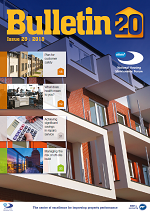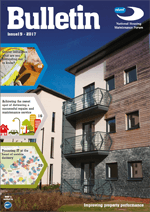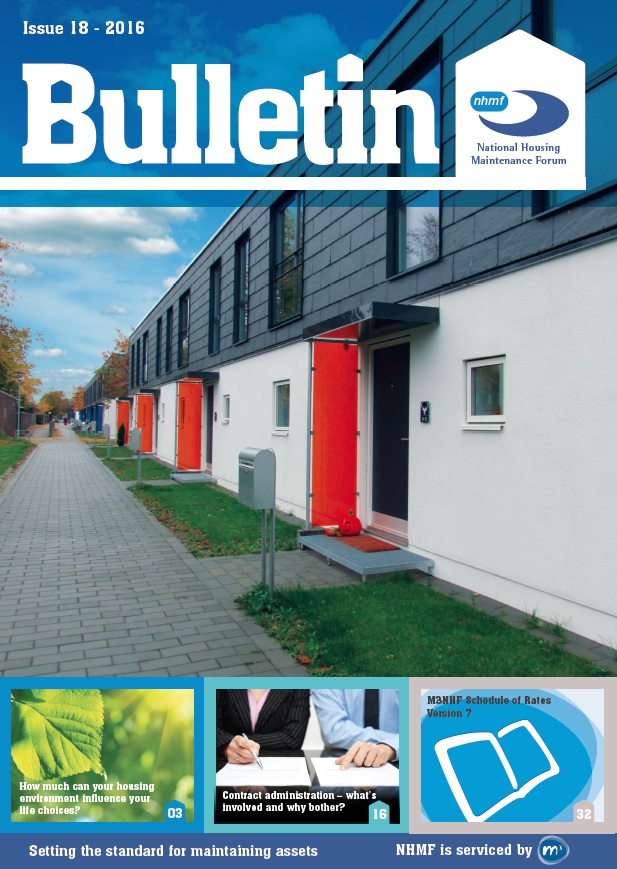NHMF best practice
These two new best practice sections will help social landlords to maintain quality homes in an increasingly challenging economic environment. The Compliance Section has a set of topical guides summarising social landlords’ responsibilities for meeting essential statutory health and safety requirements and explain how to do this economically and efficiently. The Fuel Saving Section explains how to include a fuel saving strategy as a key aspect of an organisation’s business plan. The Guide then sets out how to develop a practical improvement strategy as an integral part of the asset management programme and how to successfully deliver the improvements and manage the risks. There are also best practice training courses which relate to this guide.
Chapter 1: Developing a fuel-saving strategy - agreeing the need
"A housing energy strategy is an essential component of any housing organisation’s corporate environmental sustainability strategy, and should be an integral part of its asset management strategy". To be effective, a housing energy strategy should be fully supported by senior management with ownership and buy-in from across the organisation.
One social landlord (as well as other landlords anecdotally) that has made the business decision to invest in high-levels of fuel saving in their stock have seen zero or reduced rent arrears, as well as fewer voids because tenants can afford their energy bills. Landlords also need to understand their stock so that they know which are the least energy-efficient homes and why, and what investment is needed to improve them. Installing fuel-saving measures can improve residents’ health; it also generates economic benefits for the community because typically it will: employ local labour, including SMEs; provide local employment and training; and increase local economic activity. Evidence to help landlords estimate such benefits for their asset management programmes to strengthen the business case for fuel saving home improvements can be referenced in the UK Green Building Council’s campaign document A Housing Stock Fit for the Future.
For those social landlords that have not developed a fuel saving strategy as part of their business plan, the Governing Body should be persuaded it needs to develop one. It is recommended that this should be approached in two stages, the first being an agreement to develop a fuel-saving strategy and to provide a budget for the necessary analyses. The second stage (see Chapter 3), involves presenting the detailed results of this analysis to the Governing Body as a quantified fuel-saving strategy, so that appropriate targets can be incorporated into the business plan.
This chapter explains how to get the Governing Body’s agreement to developing a fuel saving strategy that sets energy performance targets, such as minimum Standard Assessment Procedure (SAP) energy ratings.
It should start with identifying which of the business drivers listed in the Introduction above are most important for the organisation.
Such drivers will need to compete with the pressure for housing associations to build more new homes. Additional investment for fuel saving improvements has to come from income rather than borrowing because this is focused on new homes. All social landlords will be committed to providing and maintaining affordable housing but, with the increasing cost of heat, power and water and other utility bills, housing that is truly affordable means more than subsidised (below market) rents. Providing truly affordable housing involves consideration of all housing related costs (i.e. rent, service charges, energy and utility bills) and assessing these costs against residents’ incomes. Each landlord should identify what housing costs are affordable for its residents, but in the absence of specific income information a prudent approach would be to assess what is affordable for those on the lowest incomes. This is even more important in the light of the 2015 Summer Budget changes to benefits.
Regulation will be another important business driver, particularly in relation to fuel poverty.
For example, social landlords in Scotland are required to meet the Energy Efficiency Standard for Social Housing (EESSH) by 2020. The EESSH website provides tools and guidance to landlords on what measures will be required for different property types and at different dates. It proposes typical energy performance targets such as minimum SAP scores (60 – 69, i.e. the upper part of EPC band D). These targets will supersede the energy targets and guidance in the Scottish Housing Quality Standard (SHQS) from 2015. The Standard aims to improve the energy efficiency of social housing, so as to reduce fuel consumption, fuel poverty and the emission of greenhouse gases. Meeting this standard will help to achieve the Climate Change (Scotland) Act 2009 target of reducing carbon dioxide emissions by 42 per cent by 2020 and 80 per cent by 2050. It will also help address fuel poverty levels in the social housing sector and help in achieving the Scottish Government’s commitment to ensure that no-one in Scotland is in fuel poverty, as far as practicable, by 2016. Progress on meeting this standard will be monitored by the Scottish Housing Regulator.
Similarly in Wales, social landlords need to meet the Welsh Housing Quality Standard by 2020 which must be capable of being adequately heated at an affordable cost to the residents. This is defined by an energy performance of at least SAP 65 (which is EPC band D).
The Government’s Fuel Poverty Strategy for England March 2015 put energy efficiency and demand management at the heart of its energy and climate policy. The Fuel Poverty (England) Regulations 2014 set a target of minimum EPC band C (i.e. SAP 69-80) for fuel poor households by the end of 2030 (as far as reasonably practical). The Strategy also sets interim milestones for 2020 (band E, SAP 39-54) and for 2025 (band D, SAP 55-68). The Government will monitor progress towards achieving its strategy across all housing stock - social housing stock is not exempt. While the Government suggests in the strategy that fuel poverty is not such a problem in social housing, official fuel poverty statistics show that one in ten social households are currently in fuel poverty. Landlords know how important fuel poverty is for their residents, something that will increase with proposed reductions to benefits and higher energy bills.
In Northern Ireland, following consultation in 2014 on the previous Fuel Poverty Strategy Warmer Healthier Homes - a new Fuel Poverty Strategy for Northern Ireland (2011), a new Affordable Warmth Scheme has been introduced. The Scheme is designed to address fuel poverty in the private sector i.e. the grants are only available to owner occupiers and private landlords. It funds insulation, air-tightness, window and heating improvements with grants up to £7,500, with an additional £1,000 for solid-walled properties.
While the different fuel poverty regulations may be seen as a business driver, it is important to understand that each Government’s own statutory fuel poverty standards are inadequate, with the rising costs of supplying energy and other utilities, to ensure affordable warmth in 2020.
For example, EPC Band C (SAP 70) just about delivered affordable warmth in 2012 but work for some landlords has demonstrated that a minimum of SAP 80 will be required by 2020. Consequently landlords should not simply aim to meet these minimum statutory targets by the deadline set out in the regulations. Better standards will be required to protect residents against fuel poverty, even in the short term. Even though substantial investment may be required for some stock, landlords need to consider setting fuel saving targets suitable for the longer term based on projected 2020 energy prices at least to ensure homes remain affordable. See Chapter 2 for detailed analysis.
To make the initial business case to the Governing Body, the Director with responsibility for asset management should establish how much the organisation is already committed to spend on its stock and provide a commentary on what will be achieved (i.e. establish a "business as usual" base case).
This will include reactive repairs, planned maintenance and cyclical maintenance programmes, which are designed solely to maintain the quality of properties, typically meeting the Home Standard in England (a standard that is generally seen as inadequate to safeguard against fuel poverty). Only the improvement programme is designed to raise the standard of the stock. One landlord uses essential, desired and aspirational in its appraisals when deciding how to scope out works to its non traditional stock which is known as PRADA (properties requiring a different approach).
Housing Management and Customer Services should be consulted about current rent arrears, void levels and periods, as well as the nature of customer complaints. This will provide an assessment of how the stock is performing for residents and help to identify potential problems, such as rent arrears increasing.
Such assessments should be correlated against the 30 year NPVs calculated on an organisation’s stock. It will also help to predict future demands, such as increasing numbers of complaints about condensation and mould, or higher void levels because residents request transfers from cold and damp homes (i.e., poor energy performance). Input from Customer Services and Finance teams will identify the business challenges that welfare reform poses for the organisation’s residents.
Much of this information should be available from existing KPIs that landlords monitor but the process of building the business case for the Governing Body will identify what other KPIs should be considered.
For example, fuel poverty will be important and may require several KPIs, including the incidence of fuel poverty among residents and the energy performance of each property type (SAP or EPC band). Each Government has set its own indicators against which it will monitor the progress of its fuel poverty strategy. In England, the Strategy proposes a range of indicators (still to be fully defined) to monitor progress for different tenures against the national average. As well as measures of energy efficiency, these include numbers of off-gas homes, the use of renewable energy, households with children under 16 and the incidence of poor health.
The combination of committed stock maintenance expenditure together with current and future demands will provide the Governing Body with the business risks associated with not having a fuel saving strategy, including the possibility of HHSRS Category 1 failure for "excess cold".
This is generally interpreted in practice as SAP 35 or lower. Governing Bodies should be aware that in the case of a Category 1 hazard, unless the landlord takes action as a matter of urgency, then the Local Authority can take action itself and recharge. This stage is essential to present senior management and the Governing Body with a vision of what the organisation could and should be doing. It should result in a mandate and budget to commission the detailed analysis required to develop an improvement strategy to reduce fuel use with aims, objectives, targets and standards.
Winning hearts and minds is essential, particularly when landlords are looking to cut back on expenditure.
Next Chapter




